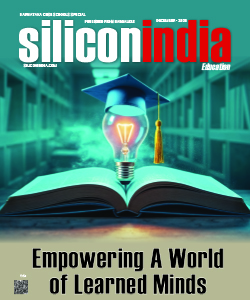Digital solutions to unlock India's Gas Power potential

There are multiple potential digital interventions across power generation, transmission and distribution. In a recent interaction with the Editor of Siliconindia, Som Shantanu, Executive – Technology, GE Gas Power Asia, shared his insights on how Digital solutions is unlocking India's Gas Power potential.
How is technological adoption aiding in unlocking the potential of the Gas Power business in India?
India is undergoing a rapid energy transition with more renewables coming online and contributing towards decarbonization of the power sector to some extent. However, majority of the traditional power generation is still dependent on thermal sources of energy, primarily coal, that is responsible for 49% of the total carbon emissions in the country.
Taking urgent steps to start decarbonizing the power sector would entail not just connecting more renewables to the grid but also adopting coal-to-gas switching – a powerful way to rapidly reduce carbon emissions from generation of electricity. Such a technology shift will lead to a scenario that will also accelerate addition of more renewable energy (RE) to the overall installed base, as higher efficient combined cycle gas power can provide the necessary infrastructural backbone needed when RE is not available. Gas Power is cleaner, flexible, sustainable, reliable and can be ramped-up and down to meet the supply-demand gap in a short time span without impacting the grid stability and reliability.
It’s encouraging to see the steps taken by the Government of India to move towards a gas-based economy by aiming to increasing share of natural gas power in the country’s primary generation mix from 6% to 15 % by 2030. Investments in building gas pipeline network and new gas import facilities to link all states with currently six gas terminals also addresses the availability concerns.
To ensure establishing a sustainable energy mix, India would need an active play of the RE, battery, gas power either based on natural gas or other carbon neutral fuel like Hydrogen. While producing green hydrogen and depending on battery storage for longer duration (more than 8hrs) are expensive and have high significant implications on the levelized cost of electricity (LCOE), high efficiency combined cycle natural gas power technology can readily be leveraged to act as a bridge to supply efficient, sustainable, reliable and cost-effective greener electricity for decades to come.
GE Gas Power has a fleet of over 260 gas turbines (GT) powering various industrial and utility scale power plants across the country. These include advanced heavy-duty GTs like F, B and E-class and Aero-derivative GT units. GE also has an active JV with BHEL – known as BGGTS (BHEL-GE Gas Turbines Services Pvt. Ltd.), that is a classic example to showcase the transfer of advanced technology by a hi-tech industrial company like GE through the partnership with India-based power infrastructure leader like BHEL. With new technology innovations being implemented across the globe, there has been a significant focus on repair systems that can deliver solutions leading to increased operational efficiency, conforming closely to OEM specifications. With that in mind, BGGTS is delivering total solutions for parts planning, field support services, technical consultancy, Gas Turbine up-rates leading to improvement in power plant performance and efficiencies.
What are the changes that digitization has brought in the Gas Power business?
The South Asian power sector is evolving rapidly through changes in regulations, demand and technology. While the sector has witnessed strong growth and improved accessibility, challenges remain across the value chain. Generating assets increasingly face margin pressures owing to limited fuel supply (for thermal assets) and increased competition in the power market (from renewables). T&D (Transmission and Distribution) in turn is plagued with legacy issues of constrained capacity and poor efficiency. In this environment, there is an increasing need for players in the power sector to rethink the way they do business.
During the energy transition using different carbon neutral technologies for power and carbon captures, digital technology continues to act as a key enabler – orchestrating the world’s energy through software.
Digital technology presents exactly this opportunity i.e., reshaping the way companies think about technology, data, new customer habits, new ways of working and new business models. Digitalization is allowing remote turbine monitoring and can also predict forced outages in gas turbines and prioritizing alternate power generation assets to take over and prevent undesired generation shortfalls, thereby establish a robust, reliable, and sustainable grid. With an elaborate set of remote monitoring tools and sensors and data analysis, the system can pre-empt issues at the equipment or power plant level in advance, allowing timely outage measures to be taken to minimize downtime of the plant. The BGGTS RM&D (Remote Monitoring and Diagnostics) centre is currently extending its digital services to IOCL where the team is monitoring powering equipment at eight IOCL refineries located across India.
As multiple sources of power generation are connected to the grid, the system becomes complex and it often becomes difficult to manage plug and play of the right energy source. Digital technology comes handy in such a scenario – effectively managing load distribution at the grid level and also monitoring the amount of power to be extracted from a particular resource. GE also offers power generation control systems solution portfolio features that deliver robust process control with seamless connectivity and real-time information management—to help customers enhance uptime and improve output. For instance, GE has digital software that can ramp-up and down a gas turbine in a combined-cycle power plant to meet the demand-supply gap, without inducing fluctuations in the grid.
GE’s industrial application software and services that can maximize asset reliability, optimize power plant efficiency and boost power plant operator’s effectiveness – the keys to thriving in today’s dynamic energy market.
Elucidate on the development that is taking place in terms of Cyber solutions to secure the Gas Power business.
Today, digitalization is pervasive across industries. Increased connectivity—including the increasing significance of the Industrial Internet of Things (IoT), supply chains, customers, and operations—brings new operational cybersecurity risks and threats that demand attention.
There are multiple potential digital interventions across power generation, transmission and distribution. Many of these interventions are fairly well-established and implemented in other geographies. Going ahead, we expect India’s power sector to adapt similar solutions and also develop completely new ones to meet domestic challenges.
Cyber solutions are adding flexibility in the value chain as the renewable mix increases and demand patterns shift. Similar, generation planning is aiding the increase of operational flexibility. Operationally, digital tools to optimize conversion efficiency, unit heat rate and load allocation across units are being explored, coupled with digital solutions for maintenance, surveillance and inventory reconciliation. There is immense activity around expanding cyber solutions to secure the gas power business.
GE Gas Power’s products operate in a highly dynamic operating environment marked by threats that are constantly changing and evolving. As such, it is critical to maintain product security throughout the product lifecycle of marketed products, including components sourced from third party suppliers. We have developed a product security program based on industry-leading standards, such as IEC 62443, to support the engineering and configuration of secure products across people, process, and technology. Our advanced solutions and modular offerings help customers quickly apply the solutions they need.
What could we expect in the digitized Gas Power business in the future?
As the global energy transition evolves further, there is a clear case of using hybrid energy systems to meet the electricity demand and supply gaps. The digital technology will continue to play a key role in sustainable inclusion of these seemingly dissimilar but complementing energy systems into the same energy framework. It will help to enhance flexibility of the system to switch from one energy source to another (Wind, Solar, Gas, Battery, Hydro and Nuclear) and transmit reliable energy onto the grid and monitor grid vulnerability. The two power generating sources need not be even in the same location, as long as they operate in harmony and are parts of the same grid.
Decarbonization, decentralization, democratization and digitalization as mega trends disrupting the power sector. Technology companies with advanced machine learning algorithms, cloud storage, and valuable relationships with homeowners or power plant operators, may use these to provide new energy services.
Read More News :
Robotics to enhance productivity & flexibility of the manufacturing industry
Digital transformation: A multidisciplinary reflection and its different stages





